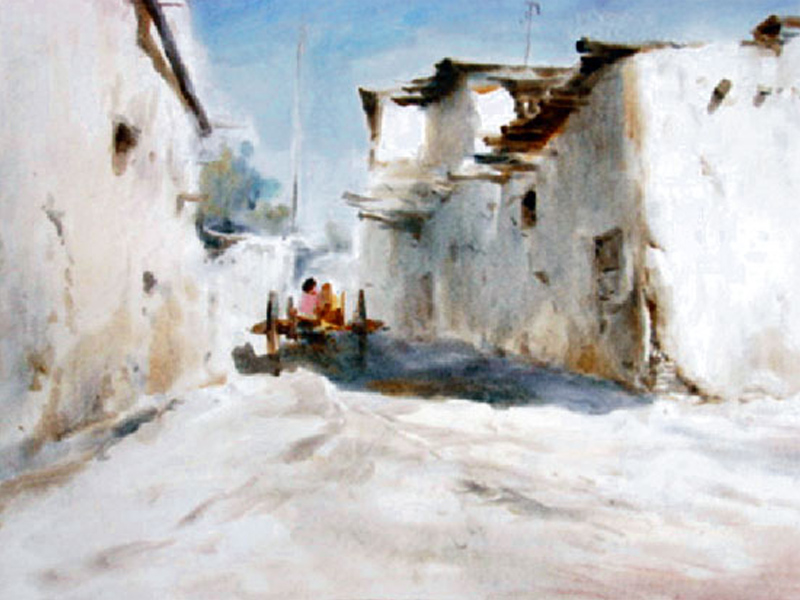



Attraction

Recreation

Have you ever stood by the window on a rainy day? With accurate brush strokes Allabergenov reproduces on the canvas his own perception of the panorama through the prism of a transparent window washed by the rain. And the landscapes of this “square” are so comprehensive that the city of Khorezm stands before one’s eyes: lakes with reed, a courtyard with tandyr (an earthen oven), mosque domes whitened by the Sun, and narrow streets.
Ancient cities, architectural structures, old streets and buildings, and the portraits of long-livers are connected by a single meaning in the artist’s works. In Allabergenov’s landscapes there are many features prompting deep contemplation. Through his artistic insight, the author lovingly produces portraits such as “Mother”, and “The Elder”. In the series called “Priaralye” (The Aral Sea Area) the glory of bygone years is masterfully unravelled. Not a single real life episode, nor a detail, however insignificant, has escaped his careful eye, and has been performed with great love.
For Allabergenov there is no such notion as “relevant subject”. His works are characterized by professional artistic interpretation, bright and lively colours, and non-standard use of shapes. His art is primarily a call of the soul, an insight, and a comprehension of the world around through his own “self”. This was evidenced at the artist’s personal exhibition held at the Central Exhibition Hall of the Academy of Arts in 2000, which demonstrated many of his works, where the lead theme was his Soul.
The secret of success of the artist who, while living and working in a province, has been able to reflect the rhythm of the capital city, is perhaps the fact that Allabergenov is a very sociable person, always in a state of creative search. He can often be seen among lead artists from the capital city, in a Khorezmian garden, en plein air. He also frequently visits Tashkent to see his friends. The result of his creative searching is evident – success at the next personal exhibition at the prestigious Central Exhibition Hall in the capital city.
Allabergenov does not seek to create his pictures with an avant-garde method; he is guided by his own sentiments and mood, based on which he constructs the shapes. He created several series of paintings dedicated to Khiva and Urgench, in which the streets have their own unique spiritual space, outlines and colouring. This warmth can also be sensed in his series “The Tower of Islam Khoja”, “The Old Mosque”, and “The Old City”. Majestic “Guldursun” and mysterious “Ancient Urgench” invoke contemplations. The author accentuates spiritual space of the old city, trying to convey his impressions through the diversity of shapes and unusual compositional layout.
For the artist, the spiritual space covers not only the appearance of the cities, but also people who live there. Allabergenov’s painting “The Weaver” appears to be similar to Ben’kov’s “Khivinka” (“A Woman from Khiva”) in theme and composition. The canvas features an elderly woman at a distaff. Her head, like a cotton thread, is white – a symbol of spiritual purity. The woman’s face is painted with shades or reddish colour, the colour of a deep suntan, which signifies life spent in continuous labour.
Working on the portraits of elderly people, the artist focuses on their character and movements. The heroes of his portrait-paintings such as “The People of Urgench”, “Chess-player”, “The Masters”, and “Potter” are strong, enduring and open people. The artist emphasizes traditional, very nation-specific features of a character, “handing them over” to the next generation as a baton of spiritual richness.
The personal exhibition of Atahan Allabergenov, graduate of a theatre department of the Tashkent Institute of Theatre and Art (currently the National Institute of Arts and Design named after K. Behzad) presented both paintings and set sketches. Quite notable are the works performed for the plays “Somonchi” (“Straw-maker”) by E. Vahidov, “Macbeth”, “Afandi”, and “Jaloliddin Manguberdi”. In conveying negative features of the official’s character, the author masterfully used elements such as an old donkey-cart, straw bundles, and torn pages of opened books. When assessing people around him, the artist also seems to be looking at himself with a detached eye. In his “Self-portrait” one can notice an aspiration for knowing oneself through the search of traditional ways, and for identifying one’s place in the spiritual universe.
Nodir Normatov